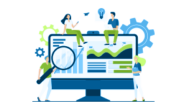SAP Data Governance
Filter By
Browse By
- SAP Analytics and AI
- SAP Application Development and Integration
- All SAP Application Development and Integration
- SAP ABAP
- SAP ABAP Development Tools
- SAP ABAP Test Cockpit
- SAP API Management
- SAP BAPI
- SAP Basis
- SAP BRF
- SAP Business Application Studio
- SAP CMS
- SAP Design Studio
- SAP Development Tools
- SAP DevOps
- SAP EAI
- SAP EDI
- SAP Extension Suite
- SAP Fiori
- SAP Fiori Elements
- SAP Integration Suite
- SAP Low Code Application Development
- SAP Low Code Automation
- SAP Netweaver
- SAP Release Management
- SAP UI5
- SAP Web Application Server
- SAP Web IDE
- SAP Business Process Management
- SAP Center of Excellence
- SAP CIO
- SAP Customer Experience
- SAP Data and Data Management
- All SAP Data and Data Management
- SAP BW
- SAP BW/4HANA
- SAP Crystal Reports
- SAP Data Archiving
- SAP Data Center
- SAP Data Governance
- SAP Data Integration
- SAP Data Migration
- SAP Data Quality
- SAP Data Services
- SAP Data Strategy
- SAP Data Visualization
- SAP Data Warehouse Cloud
- SAP DMS
- SAP Document Control
- SAP EIM
- SAP ETL
- SAP ETL Tools
- SAP HANA
- SAP HANA Administration
- SAP HANA Deployment Infrastructure
- SAP HANA Studio
- SAP Master Data
- SAP Master Data Governance
- SAP MDM
- SAP Enterprise Architect
- SAP Enterprise Asset Management
- SAP ERP
- SAP Finance
- All SAP Finance
- SAP Accounting
- SAP AR AP
- SAP Asset Accounting
- SAP Billing Systems
- SAP BPC
- SAP BRIM
- SAP Cash Management
- SAP Central Finance
- SAP Controlling
- SAP COPA
- SAP Cost Center Accounting
- SAP Currency Risk
- SAP e-invoicing
- SAP FICO
- SAP Finance Automation
- SAP Advanced Financial Closing
- SAP Financial Consolidation
- SAP Financial Planning
- SAP FX Risk
- SAP General Ledger
- SAP Global Tax Management
- SAP Hyperion
- SAP Order to Cash
- SAP Payment Processing
- SAP Profitability Analysis
- SAP Rebate Management
- SAP S/4HANA Finance
- SAP SWIFT Compliance
- SAP Treasury Management
- SAP Universal Journal
- SAP Governance Risk and Compliance
- SAP Human Capital Management
- SAP Intelligent Technologies
- SAP Platform and Technology
- All SAP Platform and Technology
- SAP Business Technology Platform
- SAP Cloud
- SAP Cloud Connector
- SAP Cloud Integration Platform
- SAP Cloud Migration
- SAP Cloud Platform
- SAP Cloud Providers
- SAP Cloud Strategy
- SAP Digital Signature
- SAP Container Platform
- SAP HANA Enterprise Cloud
- SAP Digital Asset Management
- SAP Smart Forms
- SAP HEC
- SAP Digital Integration Hub
- SAP Hyperscalers
- SAP Infrastructure
- SAP Messaging
- SAP Quality and Testing
- SAP Security
- SAP Spend Management
- SAP Supply Chain Management
- All SAP Supply Chain Management
- SAP APO
- SAP Asset Management
- SAP Business Network
- SAP Digital Manufacturing Cloud
- SAP Digital Twin
- SAP EWM
- SAP IBP
- SAP Inventory Management
- SAP Label Printing
- SAP Logistics
- SAP Manufacturing
- SAP Manufacturing Automation
- SAP MES
- SAP MII
- SAP MM
- SAP MRO
- SAP MRP
- SAP Order Management
- SAP Plant Maintenance
- SAP PLM
- SAP Production Planning
- SAP S&OP
- SAP SD
- SAP SPM
- SAP Supply Chain Planning
- SAP Track and Trace
- SAP Transportation Management
- SAP System Administration
Data Governance: An Overview and Key Considerations
What Is Data Governance?
SAP data can deliver innovation, drive user experience, and provide competitive advantage. The process of marrying SAP data with non-SAP data from different systems — from Internet of Things devices to the back office to an organization’s web systems — is defining data culture around the world.
Simply combining data, however, is not enough. Proper management is essential to realizing its value.
Data governance is considered a core component of an effective data management strategy. Data governance can ensure that data is consistent, accurate, and protected.
The Data Governance Institute (DGI) defines data governance as “a system of decision rights and accountabilities for information-related processes, executed according to agreed-upon models which describe who can take what actions with what information, and when, under what circumstances, using what methods.” (Read the DGI’s 10 rules of engagement.)
Data Governance: An Overview and Key Considerations
What Is Data Governance?
SAP data can deliver innovation, drive user experience, and provide competitive advantage. The process of marrying SAP data with non-SAP data from different systems — from Internet of Things devices to the back office to an organization’s web systems — is defining data culture around the world.
Simply combining data, however, is not enough. Proper management is essential to realizing its value.
Data governance is considered a core component of an effective data management strategy. Data governance can ensure that data is consistent, accurate, and protected.
The Data Governance Institute (DGI) defines data governance as “a system of decision rights and accountabilities for information-related processes, executed according to agreed-upon models which describe who can take what actions with what information, and when, under what circumstances, using what methods.” (Read the DGI’s 10 rules of engagement.)
Key Considerations for SAPinsiders
The following steps can help you implement effective data governance:
- Create a strong business case for data governance. According to SAP partner Winshuttle, you need to be able to clearly communicate the value of your data to gain support from leadership. Winshuttle’s Winshuttle Foundation and Winshuttle Studio offer data management capabilities. According to the vendor, your data should be maintained through a data governance program that can ensure data quality and proper management, while complying with regulations to keep the data safe and effective.
- Increase revenue potential with a strong data governance foundation. Consider the approach of Breakthru Beverage Group. On a mission to become a fully integrated, data-driven business, the company first built a foundation with its data governance program. The initiative to cleanse and conform its material, vendor, and customer data was supported by SAP partner Protiviti, and resulted in a scorecard on data cleanliness as well as a downstream benefit: revenue generation, by enabling the business to more quickly activate products and more accurately report on them. Read the full data story.
- Set the stage for standardization and automation capabilities. In 2016, we wrote about Keurig Green Mountain’s approach to data governance. In response to meteoric growth and a growing love of the single-cup brew, the company undertook an ambitious data governance project. It transitioned from a data maintenance to a data governance organization. At the time, Keurig’s Director of Master Data Management Business Process Eileen Hanafin said its data governance initiative set the company up for future standardization and automation capabilities with a focus on continuous improvement.
19 results
-

Why Data Governance Is the Key to Success
Reading time: 3 mins
In today’s digital age, data has become an invaluable asset for businesses across all industries. It fuels decision-making processes, drives innovation, enhances customer experiences, and enables companies to stay competitive in a rapidly evolving marketplace.
-

The Rising Importance of ESG Reporting for Businesses: Challenges and Opportunities
Reading time: 2 mins
In recent years, environmental, social, and governance (ESG) practices have emerged as critical concerns for organizations worldwide. The impact of how a company addresses these issues goes beyond the brand image—it affects hiring practices, profitability, legal liabilities, and the fundamental ability to conduct business.
-

Navigating the Data Governance Journey: Linking Business Goals and Success
Reading time: 3 mins
Embarking on a data governance journey commonly starts with a strong sense of excitement, but it can result in frustration if not carefully aligned with significant business goals. The story of a typical data governance initiative often involves initial inquiries and disengagement.
-
-

Data360 Analyze – Solution that Integrates Self-Service Data Prep with Advanced Data Quality and Robust Data Governance
Reading time: 1 mins
Empower users to discover and share insights faster with self-service data prep and analytics.
-

How to Establish a Strong Data Governance Framework with Data360 Govern
Reading time: 1 min
Learn how to proactively find, understand, and manage data for better business outcomes based on trusted data.
-

How a Data Catalog can Unlock the Power of your Organization
Reading time: 6 mins
A data catalog is a comprehensive repository of metadata, essential for understanding and managing an organization’s data. It includes technical, business, and operational metadata to provide insights into data structure, context, and usage. Key elements of a data catalog are an intuitive user interface, business context, extensive data information, robust governance, and automation. It addresses…
-

The Critical Role of Data Governance in ESG Reporting and Sustainability
Reading time: 3 mins
In today’s global business landscape, Environmental, Social, and Governance (ESG) factors are paramount for organizations committed to sustainable practices. Central to this is effective data governance, ensuring accuracy and reliability in ESG reporting. Discover why data governance is crucial for ESG, preventing reputational damage and enabling informed decision-making. Learn from real-life examples like Unilever’s robust…
-
-

- SAP Data Governance
 Premium
Premium
A Virtual Win: Why SAP Integration is Vital for ServiceNow
Reading time: 8 mins
Despite some positive signs in recent months of slowing interest rates and inflation, the global economy will remain in a volatile state as we head into 2024, at least according to the World Economic Forum. For most organizations faced with the prospect of continued uncertainty, this raises a few questions around investment and competitiveness. There…
-

- SAP Data Governance
 Premium
Premium
Cloud Data Compliance – Common Questions to Consider
Reading time: 3 mins
Compliance, like security, is a non-negotiable goal, and one that is increasingly complex. Cloud computing has clearly compounded this challenge with additional requirements such as encryption, auditing, data location, and data separation rules. While several factors are involved, organizations can increase confidence in their IT staff by addressing these common questions and avoid common pitfalls.…
-

- SAP Data Governance
 Premium
Premium
Make 2023 The Year of Building Supply Chain Data Foundation
Reading time: 7 mins
As we head into the new year, you have already read many articles predicting supply chain trends for 2023. I am not a big fan of predicting trends when it comes to supply chains. My primary reasoning is that these trends are not a surprise for seasoned supply chain leaders and executives. These leaders and…
Become a Member
Unlimited access to thousands of resources for SAP-specific expertise that can only be found here.
Become a Partner
Access exclusive SAP insights, expert marketing strategies, and high-value services including research reports, webinars, and buyers' guides, all designed to boost your campaign ROI by up to 50% within the SAP ecosystem.
Upcoming Events
Related Vendors
Your request has been successfully sent


